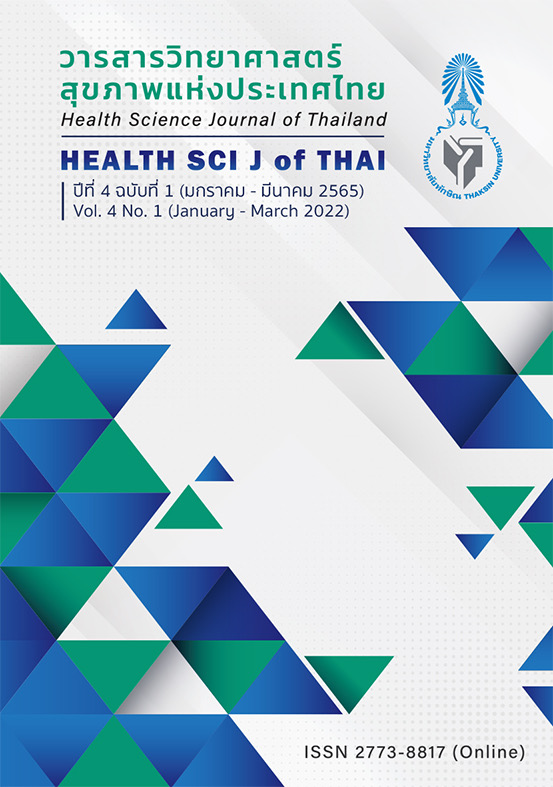Antioxidant and Antiproliferative Activities against HepG2 Cell Line of Ethanolic Extract from Leaves and Shoots of Spilanthes acmella
Main Article Content
Abstract
The purpose of this study was to investigate the total phenolic contents, antioxidant activity, and antiproliferative activity against HepG2 cell line from leaves and shoots of Spilanthes acmella. Total phenolic content was analyzed by Folin-Ciocalte method. Antioxidant activity was used DPPH radical scavenging assay and FRAP (Ferric reducing/antioxidant potential). The antiproliferative activity against liver cancer (HepG2) cell line was determined by sulforhodamine B (SRB) assay. The result showed that the ethanolic extract from leaves at the Paddy field had the highest amount of total phenolic content. There was 14.32±0.01 μg GAE/mg sample. Antioxidation activity assay, the result showed that the leaves extract at Paddy field had the highest antioxidant activity which showed IC50 value of DPPH radical at 262.21±1.13 μg/mL and FRAP value of 252.71±2.33 μg TEAC/mg sample. Antiproliferative activity against liver cancer (HepG2) cell line, the result showed that the leaves extract at the Corn field had the highest antiproliferative activity which showed IC50 value of growth inhibition at 464.70±133.57 μg/mL. The result show that the antioxidant activity of leaves and shoots extract at Corn field and Paddy field had the statistical significantly positive correlation with HepG2 cell growth inhibition at 0.05 (R2 = 0.8727, p < 0.05). These results may be used as preliminary data for further study of the anticancer activity against liver cancer cells of Spilanthes acmella extract.
Article Details

This work is licensed under a Creative Commons Attribution-NonCommercial-NoDerivatives 4.0 International License.
References
Fongchan S, Vorapongsathorn S, Bhavabudananda P, Chooratna K. Liver cancer prevention and control. Thai Cancer J 2019; 39(2): 65 – 74. (In Thai)
National Cancer Institute, Ministry of Public Health. Hospital-Based Cancer Registry 2017. Bangkok: Pronsup Printing Co. Ltd; 2018. (In Thai)
Laupattarakasem P, Sripa B, Laupattarakasem W. Antimigration of cancer cells by Derris scandens on cholangiocarcinoma cells. Srinagarind Med J 2007; 22(4): 339 – 345. (In Thai)
Pongnaratorn P. A Literature review of the pharmacological effects of Spilanthes acmella: anti-inflammatory and analgesic of muscles. Srinagarind Med J 2016; 31(4): 245 – 249. (In Thai)
Gulam NN, Wani TA, Shrivastava M, Wani A, Shah SN. Spilanthes acmella an endangered medicinal plant – its traditional, phytochemical and therapeutic properties – an overview. Int J of Adv Res 2016; 4: 627 – 639.
Prachayasittikul V, Prachayasittikul S, Ruchirawat S, Prachayasittikul V. High therapeutic potential of Spilanthes acmella: a review. EXCLI Journal 2013; 12: 291 – 312.
Prachayasittikul S, Suphapong S, Worachartcheewan A, Lawung R, Ruchirawat S, Prachayasittikul V. Bioactive metabolites from Spilanthes acmella Murr. Molecules 2009; 14:850 – 867.
Nabi NG, Shrivastava M. Estimation of total flavonoids and antioxidant activity of Spilanthes acmella leaves. Pharm Biosci J 2016; 4(6): 29 – 34.
Zimmerman R, Cerutti P. Active oxygen acts as a promoter of transformation in mouse embryo C3H/10T1/2/C18 fibroblasts. Proc Natl Acad Sci U S A 1984; 81(7): 2085 – 2087.
Singh S, Verma KS, Singh KS. In vitro investigation of anti-cancer potential of Spilanthes acmella. J Pharm Sci & Res 2020; 12(1): 124 – 128.
Boontha S, Thoedyotin T, Saengtabtim T, Im-erb P, Chaniad N, Buranrat B, Pitaksuteepong, T. Cytotoxic, colony formation and anti-migratory effects of Spilanthes acmella (Asteraceae) aerial extract on MCF-7 cells and its cream formulation. Trop J Pharm Res 2020; 19(1): 17 – 24.
Lalthanpuii PB, Lalchhandama K. Anticancer and DNA-protecting potentials of Spilanthes acmella (toothache plant) grown in Mizoram, India. Journal of Natural Remedies 2019; 19(2): 57 – 63.
Pooma R, Suddee S, editors. Thai plant names Tem Smitinand (revised edition 2014). Bangkok: Office of the Forest Herbarium, Department of National Park, Wildlife and Plant Conservation; 2014. (In Thai)
Buranrat B, Mairuae N, Kanchanarach W. Cytotoxic and antimigratory effects of Cratoxy formosum extract against HepG2 liver cancer cells. Biomed Rep 2017; 6(4): 441 – 448.
Jumroon A, Youryon P, Joyroy B. Analysis of antioxidant activity in Musa (ABB group) ‘Kluai Hin’ and Musa (AA group) ‘Kluai Leb Mu Nang’. Songklanakarin J Pl Sci 2015; 2(1): 38 – 42. (In Thai)
Jandaruang J, Siritapetawee J, Thumanu K, Songsiriritthigul C, Krittanai C, Daduang S, Dhiravisit A, Thammasirirak S. The effects of temperature and pH on secondary structure and antioxidant activity of Crocodylus siamensis hemoglobin. Protein J 2012; 31(1): 43 – 50.
Shian TE, Abdullah A, Musa KH, Maskat MY, Ghani MA. Antioxidant properties of three banana bultivars (Musa acuminata 'Berangan', 'Mas' and 'Raja') extracts. Sains Malaysiana 2012; 41(3): 319 – 324.
Thongdeeying P, Kitsiripipat J, Ruangnoo S, Pibanpaknitee P, Itharat A. Cytotoxic activity of Samhannachan recipe and its ingredients against lung cancer cell. Thammasat Medical Journal 2017; 17(4): 565 – 573. (In Thai)
Akanitapichat P, Sethabouppha B. In Vitro antioxidant and cytoprotective activities of extracts from four Solanum fruits. IJPS 2020; 16(1): 49 – 58. (In Thai)
Suphim B, Buranrat B, Prawan A, Kukongviriyapan V. Sensitivity of cholangiocarcinoma cells to chemotherapeutic agents and curcumin. Srinagarind Med J 2008; 23(3): 284 – 289. (In Thai)
Al-Rimawi F, Rishmawi S, Ariqat HS, Khalid FM, Warad I, Salah Z. Anticancer activity, antioxidant activity, and phenolic and flavonoids content of wild Tragopogon porrifolius plant extracts. Evid Based Complement Alternat Med 2016; 1 – 7.
Sammar M, Abu-Farich B, Rayan I, Falah M, Rayan A. Correlation between cytotoxicity in cancer cells and free radicalscavenging activity: In vitro evaluation of 57 medicinal and edible plant extracts. Oncol lett 2019; 18(6): 6563 – 6571.
Nguyen NH, Ta Q, Pham QT, Luong T, Phung VT, Duong TH, Vo VG. Anticancer activity of novel plant extracts and compounds from Adenosma bracteosum (Bonati) in human lung and liver cancer cells. Molecules (Basel, Switzerland) 2020; 25(12): 1 – 16.


